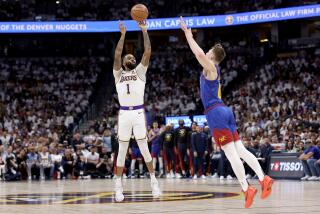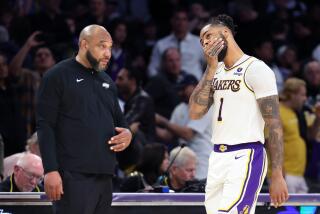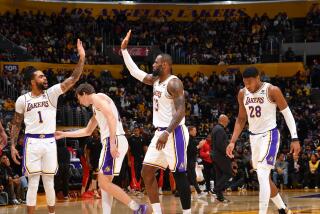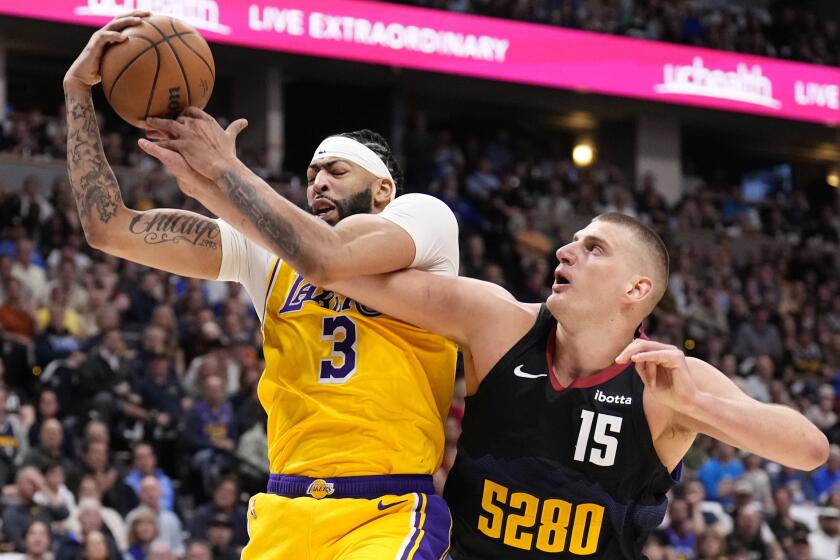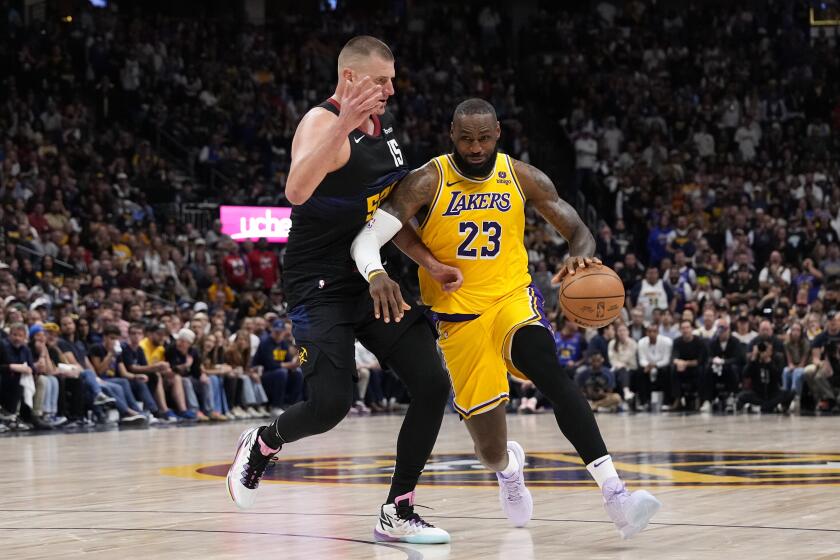Lakers’ offensive system contributed most to Pau Gasol’s decline
The lasting image of Pau Gasol’s decline in what could be his last year with the Lakers comes from this last week.
One can choose his costly turnover that became a flashpoint in the Lakers’ 103-100 Game 4 loss to the Oklahoma City Thunder. With Gasol having a clear look to take a potential game-winning jumper, Kobe Bryant led the charge that his errant pass epitomized his season-wide inconsistent aggressiveness.
Focus on Bryant and Gasol arguing with each other in the waning minutes of the Lakers’ Game 5 elimination loss to the Thunder. Gasol in his exit interview conceded the chemistry between the two never seemed as strong as it had been in the previous four seasons.
Notice Gasol’s demeanor during his exit interview. He spoke almost in resignation over the possiblity the Lakers would trade him with two years and $38 million left on his contract, particularly after Lakers General Manager Mitch Kupchak offered no assurances about his future. It showed how the ongoing trade speculation since the nixed Chris Paul deal left Gasol describing his state of mind this season as a “little bit exhausted mentally.”
But the above images don’t serve as the main reason why Gasol’s scoring dropped from 18.8 points a game to 17.4 or why he missed the NBA All-Star game for the first time since 2008. No, these images explain things a bit better. Insecure with his personnel, Lakes Coach Mike Brown leaned on Bryant to carry most of the offense at the beginning of the season. Eager to show how much he improved in his post game, Bynum continually scored around the rim and quickly transcended Gasol in the offensive pecking order. Meanwhile, Gasol suddenly became the team’s facilitator in the high post instead of operating inside.
“It has been difficult at times to be a third option,” Gasol said this week. “I’ve never experienced that in my career probably since I was very young. I still gave it my best and we’ll see how it looks next year. But it has been challenging at times.”
Oh, the formula worked at first. Bryant continuously scored points at a high volume and proved Father Time hasn’t derailed him. Bynum had such sheer power and improve foot work, very few defenses could stop him. Meanwhile, Gasol often made open mid-range jumpers when double teams forced Bynum to give up the ball.
Even if Brown believes Gasol “adjusted pretty well,” his role hardly ensured the team remained collectively strong within the Big Three. Gasol could’ve and should’ve mitigated some of that. Gasol, who admitted he has been “spoiled” in past seasons for having plays drawn up for him, could’ve offset that by fighting more for rebounds and having a larger defensive presence.
But that still didn’t solve the Lakers’ fundamental issues on offense. The moment Bryant had a bad shooting night or Bynum couldn’t get untracked becasue of persistent double teams, the Lakers failed to properly feature Gasol enough to make teams pay.
“Obviously he’s someone worthy of a lot more touches,” Bynum said. “But it just kind of happened where that’s the way it was.”
But it didn’t have to be that way.
Gasol revealed the Lakers hardly practiced other ways to utilize him, including pick-and-roll plays or sets with him on the elbows. According to Synergy Sports Technology, 28.5% of Gasol’s shots came in the post, the most of any spot on the floor. But that often happened only when Bynum, Bryant and Metta World Peace weren’t in the lineup. Brown leaned on Bryant to take 27.9% of his shots in isolation, particularly in the fourth quarter. Meanwhile, the Lakers routinely looked impatient in penetrating off ball reversals and swing passes whenever teams, such as Denver and Oklahoma City, countered the Lakers’ size.
“You have to be aware that those things are going to happen and how you’re going to counter them,” Gasol said. “It’s something to think about for the future. We’re most effective when we dominate inside and we utilize our inside game.”
But don’t put most of the blame on Gasol for not fully tapping into the Lakers’ strength. He was too busy facilitating in the high post to do anything about it.
RELATED:
Pau Gasol can’t get clarification from Lakers about his future
Pau Gasol is being unfairly scapegoated
Lakers have got next ... but beyond that, who knows?
E-mail the Lakers blog at mgmedin@gmail.com. Follow the Lakers blog on Twitter.
Lakers’ offensive system contributed most to Pau Gasol’s decline
More to Read
All things Lakers, all the time.
Get all the Lakers news you need in Dan Woike's weekly newsletter.
You may occasionally receive promotional content from the Los Angeles Times.
